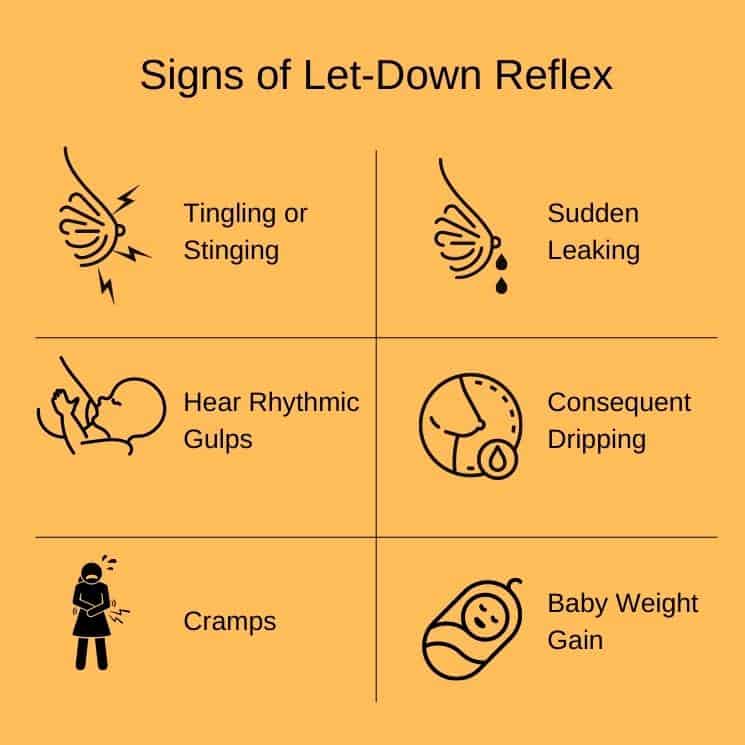-
Author: Khushboo Kirale
- >> Post Created: September 23, 2020
- >> Last Updated: April 26, 2024

Let-Down Reflex - Table of Contents
The milk let-down reflex is an integral part of breastfeeding that actually gets your milk flowing when your baby latches on your breast for a feed.
Each woman feels it differently, and some may not feel it at all. The milk let-down reflex can be affected by stress, pain, and tiredness but once feeding is established, it requires little or no thought. This article explains all you need to know about breastfeeding and let-down reflex.
How would it help? Basically, understanding your let-down reflex will help in ensuring a smooth supply of milk for your baby and further increase milk supply.
What is Let-down reflex and how it gets triggered?
Did you know what makes milk actually flow? The let-down reflex is what makes it flow.
The tiny nerves in your breasts get activated when your baby sucks on your breasts. This is caused by the action of 2 hormones—prolactin and oxytocin—that are released into your bloodstream. Prolactin helps making milk, while oxytocin causes the breast to push the milk out.
The cells around the alveoli contract and squeeze out the milk, pushing it down the ducts towards the nipple. Oxytocin also helps in widening of the milk ducts, in turn helps in easing the milk flow down from them. The milk is then released through the nipple or let-down.
Some women feel the milk let-down reflex as a tingling sensation in the breasts or a feeling of fullness, although others don’t feel anything at all.
Most mothers notice changes in their baby’s sucking pattern as the milk begins to flow, right from small, shallow sucks to stronger and slower sucks.
A few women notice that while they are feeding or expressing from one breast, milk starts to drip from the other breast too.
You need to understand and maintain your milk let-down reflex to ensure that your baby gets a smooth supply of milk. This reflex actually does not need any thought and comes naturally generally, except in the cases where women have breastfeeding problems.
Sometimes your milk let-down reflex may also happen when you just think about your baby or when you see your baby or hear your baby cry.
You could also trigger your let-down reflex by touching your breast and nipple area with your fingers or when you use your breast pumps.
People often say that your milk supply can be impacted if you are very anxious, extremely tired, upset, or in pain. The truth is that breastfeeding is a powerful process. Usually your supply will not be impacted by these factors but it is possible that the let-down may be impacted or takes a little longer than usual, causing your baby to fuss at your breasts or even latch on and off.
Read this next
When does let-down reflex occur?

The milk let-down reflex occurs when:
- Your baby sucks at your breast
- You hear, see or even think about your baby
- You touch your breasts or nipples with your fingers, or when you use a breast pump, or even hand expressing of milk
- You look at your babys’ picture
- You hear your baby or any other baby cry
- You take a hot shower
- If it’s the baby’s feeding time
- You have intercourse with your partner
The milk ejection reflex normally occurs around 2 or 3 times a feed. Mostly mothers feel the milk let down only for the first time, or not at all.
During the initial phase of breastfeeding you will notice it’s not that consistent, but it gradually becomes an automatic response as you continue to regularly breast feed and express milk.
The milk ejection reflex could also occur with stimulation of the breast by your partner.
Signs of Let-Down Reflex
In the early days you will feel your uterus contracting while you let-down, especially when it’s not your first baby.
While breastfeeding, your breasts release milk due to milk ejection or let-down reflex and you may notice these signs of the let-down reflex:
- Tingling or Stinging: There are sensations like pins and needles through your breasts along with some warm sensations.
- Sudden Leaking: Even when your baby is not breastfeeding, you may notice milk leaking or squirting out of the breast.
- Rhythmic Gulps: You may hear your baby gulping and swallowing milk in a rhythmic pattern.
- Consequent Dripping: While you are feeding your baby on one breast you may sometimes find that your other breast starts to drip milk. Further you may notice milk dripping out of your baby’s mouth.
- Cramps: During the early days post your delivery your uterus is shrinking due to which you may feel cramps in your uterus while you are breastfeeding and going through the milk ejection reflex.
- Baby Weight Gain: Slowly start noticing your baby gain weight as well as see on an average 6–8 wet diapers at the end of the day as a sign of content after breastfeeding.
Even when you are not breastfeeding or expressing, you may notice signs of the milk ejection reflex. Let-down can come quickly and unexpectedly when:
- Its feeding time
- You hear your baby cry
- You take a warm shower or
- Even when you are engaged in having an intercourse
12 Tips to encourage let-down reflex during breastfeeding or expressing
The let-down reflex holds the key to successfully breastfeeding your baby. It enables your breast milk to flow out of your breasts to feed your baby.
When the milk ejection reflex is working well, your baby gets enough breast milk to feel content, to gain weight, and to grow at a healthy pace. Here are a few tried and tested ways to aid your milk let-down reflex while breastfeeding or expressing:
- Make sure you are relaxed. While breastfeeding or expressing milk, be calm and breathe deeply and slowly. Relax yourself a bit before you take your baby to breast feed. Few mothers have expressed that having a warm drink or even listening to music helps in calming the body and mind down. A warm shower and a change of clothes also help you relax. You could also place warm towels, a few minutes before feeding, on your breasts as well.
- Gently massaging your breasts. Massage your breasts gently by strokes directed to the nipples with the edge of your fingers. Further delicately roll your nipples between your fingers.
- While expressing, think about your baby. You may find it easier to express milk when you are in close proximity of your baby. If you are away from your baby, then have a look at your baby’s photo or a video. It will help the let-down reflex.
- Massage from support partner. While expressing or feeding your baby, you could ask your support partner to give you a gentle massage on your back and shoulder. This will help you relax. However, some mothers, prefer to feed or express privately to avoid being watched at and feeling uncomfortable instead of relaxed.
- Baby latched correctly. Ensure that your baby is latched to your breast/nipple correctly. It would boost breastfeeding and milk ejection reflex.
- Make yourself comfortable. Feed your baby in an accustomed and comfortable place. Have 2–3 favorite feeding spots in your house to suit your needs and where you and your baby are comfortable. This will help you and the baby relax.
- Keep yourself hydrated and nourished. Always have a bottle of water or juice handy.
- Skin-to-skin contact. As you are aware, you and your baby share a unique bond. Skin-to-skin contact by placing your baby on your chest directly helps stimulate the milk ejection. So look, touch, and smell your baby before feed and place them in direct contact with your skin.
- Be consistent. Your body can recognize the subtle signals when you are getting ready to breastfeed. You can maintain a sort of rhythm or routine for yourself while you are prepping up to breast feed. Your body will understand these signals and support milk ejection reflex. You could also slowly train to breast feed at specific times during the day.
- Nursing supplementer device. These are really useful when you are feeling fatigued and stressed and do not want your baby to lose latching onto you.
- Avoid Soda and Caffeine. How much ever possible, refrain from overdosing on soda or coffee. Both of these are known to make you dehydrated and reduce breast milk production.
- Stay away from alcohol & smoking. Completely avoid alcohol and do not smoke. Both interfere with your natural milk let-down reflex and may upset its rhythm and flow.
You will experience that the milk let-down reflex is quite strong at the beginning of the feed and it can sometimes upset your baby’s feeding rhythm. This does not in any way mean that you are producing excess milk and can be managed by gently hand expressing a little milk, just before your feed or reclining and burping your baby in a few minutes after being latched. If you continue to notice a continuous strong let down and see your baby struggling to get into rhythm, please speak to a professional for advice.
Dealing with unexpected let-down
It’s embarrassing to be seen with patches of breast milk on clothes caused due to leaking. This, however, stops when breastfeeding is generally established. Till you and your baby together set up a breast-feeding rhythm or routine, a lot of feelings and sensations could trigger milk let-down reflex.
Till such a time that you set the routine, you should:
- Feed your baby at regular intervals
- Apply pressure to your breasts when you feel first sensations of let-down reflex
- In case your baby is not around, express milk as soon as you feel your breasts are getting full
- You could use breast pads which absorb the breast milk leaked due to milk ejection reflex
- Wear such clothing that helps in disguising your milk stains—light colors with small consistent prints. They help in hiding those stains.
- Keep spare pads and tops in handy so that you can change in case of excessive milk flow due to let-down reflex.
If you need further advice or help:
- Contact your maternal child health nurse
- Contact your lactation consultant (your maternity hospital will be able to help you with references)
How does milk let-down feel
The let-down of milk happens many times during a feed. However, you will feel varied sensations usually only during your first release. When your milk is let down, you may experience following sensations in and around your breasts:
- Burning
- Pins and needles
- Pressure
- Tingling
- Warmth
Sometimes it could be a little uncomfortable or even slightly painful. Sometimes for some women, these sensations are very strong as against a few women who don’t feel anything at all.
Not feeling milk let-down
There are a lot of women who do not feel milk let-down at all. This does not always imply that there is something wrong or that you have less milk production. Sometimes you may never notice it or you may feel it strongly in the very nascent stages of breastfeeding and over time the sensations diminish. Don’t worry, its ok.
As long as you see that your baby is growing well, you need not worry at all.
In case you observe that your baby is not gaining weight in the proportion that they should (consult your pediatrician to be sure). When confirmed that your baby is not gaining weight then this is a sign that your milk supply is low and you should contact your doctor or a lactation consultant for guidance to increase milk supply. It could be nothing but stress which may have upset your rhythm or some medication. A professional would be able to guide you well and bring the milk supply to normal.
Oxytocin and milk let-down reflex
As you are aware, the hormone oxytocin is linked to love and bonding. This hormone is released during childbirth, when breastfeeding and even during sex. This hormone makes you feel calm and relaxed.
Oxytocin is also responsible for muscle contractions that help shrink your uterus to normal size after childbirth. Oxytocin is the reason for uterine cramps as your milk lets down in the initial few weeks postpartum. The uterine cramps are also a sign that your breastfeeding is going well and your uterus is going back to its original size.
There are a few side effects one experiences due to release of oxytocin which are:
- Headaches
- Hot flashes
- Vomiting & nausea
- Night sweats
- Feeling sleepy
- Dryness in the mouth and dehydration, making you feel thirsty
Possible let-down problems

Breastfeeding for anyone does not always go smoothly. It too has its hiccups, which lead to breastfeeding issues.
Some problems related with breastfeeding are listed below are being detailed ahead:
- Slow or difficult let-down
- Painful let-down
- Hyperactive let-down
These could lead to decrease in your breast milk production as your baby can only get small amount of milk in each feed. It’s like a vicious circle.
Slow or difficult let-down reflex
There could be many reasons which could lead to a delayed let-down reflex. A few of the potential causes for slow let-down of milk are:
- Alcohol consumption
- Smoking
- Stress
- Too much Caffeine
- Cold temperatures
- Pain
- Exhaustion
- Embarrassment
- Previous breast surgery
Your baby suffers the most due to slow or difficult let down. It’s frustrating for them as they are super hungry. Your baby may express frustration by crying, biting at your breast, or refusing to latch on to your breast altogether.
You could follow the 12 Tips to encourage let-down reflex mentioned above to help stimulate your milk let-down reflex. Further you can also refer to our 22 tips to increase milk supply which eventually would lead to getting a better let down.
If you have a slow let down make sure you are feeding long enough cause your milk let-down could take a couple of minutes. If your baby falls asleep before the let down, they will not be content and wake up hungry again in no time.
Your breasts too could get overfull, which could be very painful and could cause engorgement or plugged milk ducts. Hence I strongly suggest express your milk when your breasts feel full. Then you could store and utilize the breast milk as and when your baby is hungry. (Learn more: Best Milk Storage Bags, Guide to selecting the right storage bags, Best Bottle warmers)
Painful let-down reflex
At times the milk ejection reflex could be painful. You could experience hard, swollen full breasts, stinging and aching nipples, an excessive breast milk supply, and thrush (itchy or burning nipples that appear fiery red, shiny, flaky, and/or have a rash with tiny blisters, cracked nipples, shooting pains in the breast during or after feedings, and intense nipple or breast pain that is not improved with better latch-on and positioning) are few of the common breastfeeding problems that can cause pain during let-down.
Your uterine contractions too can be very intense and painful especially in the first week postpartum.
Overall, a painful milk ejection reflex can make breastfeeding not a very pleasant experience which could eventually lead to less feeds, reduced supply of milk, and could also lead to early weaning.
Here’s what you could do if you are suffering with a painful let-down:
- Immediately treat breast engorgement, sore nipples, or excessive supply of breast milk.
- Consult your doctor if you have developed thrush.
Speak with your doctor if you could take a pain reliever like acetaminophen or ibuprofen.
Hyperactive or Overactive Milk Ejection Reflex
A very strong, hyper, or overactive milk ejection reflex causes excessive milk to flow very quickly out of your breast. You may notice your baby pulls away from your breast and starts gagging. You may also notice milk squirting or leaking heavily out of your breast. This is an indication that you have an overactive let-down (OALD).
Mothers with an OALD reflex and fast flow of milk also often have an excessive milk production.
When you have OALD, there is a possibility of your baby gagging, choking, and coughing while breastfeeding. Your baby could also swallow a lot of air along with your breast milk as he is trying to keep up with the fast flow.
This could lead to colic that can make the baby feel gassy and very fussy and irritable due to the discomfort caused. This could also lead to faster weight gain which is not in proportion to the generic levels.
A few pointers to help you slow down the flow:
- Express your breast milk before you start breastfeeding.
- Make your baby latch after the first let-down passes and the milk ejections slows down a bit.
- Half recline on a sofa or a bed, and place the baby on top of you. This way the baby would have to suck against the gravitational force. This breastfeeding position can help in slowing down the flow of milk making it comfortable for the baby to breastfeed.
- Utilize only one side of your breast per feed.
- Burp your baby in between feed and after every feed to ensure that the gasses are thrown out immediately.
- Always be very attentive when you breast feed. As soon as you feel your baby is choking or gagging remove your baby from the breast and hold them upright.
- Take professional treatment for OALD.
- Hand express or use a breast pump to express some breast milk and then try feeding again.
Let-down and pumping
Nowadays many mothers pump their breast milk. It’s always good to have an occasional pumped bottle at your disposal. This may help you especially during baby’s cluster feeding phase. Some mothers stockpile expressed milk in the freezer for unforeseen situations like extension of your time at work, a medical emergency, etc.
Whatever may be the reason, you may find that it is tough to stimulate the let-down if you are using a breast pump. It’s purely because of psychological reasons.
Pumping is not a very comfortable process altogether and some women feel rushed as well. This interferes with let-down quite a bit.
Here are some tips for you to help you stimulate the let-down reflex when pumping
- Find and go to a comfortable private area to pump
- Relax and make yourself comfortable.
- Look at the video of your baby or see a picture while you express milk.
- Have a recording of your baby cooing or crying handy and view/listen to it while pumping.
- Hold a small piece of your baby’s clothing close you in a way that you can smell it. This will help you in expressing milk through pumping.
For moms of preemies or hospitalized children, studies show that spending time engaged in kangaroo care with your little one can help you pump more breast milk.
Phantom Let-down
Have you experienced the tingling sensation in your breasts even after you have breast fed your baby or when suddenly you hear your baby cry. This is called phantom let-down, where the sensations of let-down reflex continue even after breastfeeding has ended.
These sensations occur only for a moment and generally in both the breasts at the same time.
You may feel that breast milk is about to leak out, but actually there is no milk present in the breasts.
The phantom let-down could happen long after weaning. Let me assure you there is nothing to worry about.
However, in case you see any liquid coming out of your nipples, long after weaning, then do consult a doctor immediately.
Key takeaway
In the initial weeks of breastfeeding, your milk ejection reflex or your let-down reflex may happen in a matter of seconds. However, if it’s taking some time, it’s still nothing to worry about. As the days go by, your baby and you would slowly set a routine for breastfeeding. Your body will start recognizing signs of feeding and your let-down reflex will happen more smoothly.
Soon enough, your will let-down even by the thought of your baby or by hearing your baby cry. There could be times where let-down reflex will falter than usual.
All said, always remember, breastfeeding should not be painful, and you should be able to produce and supply enough milk for your baby. In case you have any queries about milk ejection reflex or let-down reflex, do speak to a professional.
Let us know if you liked this article. Share your experience. We thrive to know from all of you how our article has helped you. Feel free to write to us anytime.
Happy Parenting!










Hello! Just dropped by to write great website. Keep up the good work youre doing!
Aw, this was a really nice post. In idea I would like to put in writing like this additionally taking time and actual effort to make a very good article but what can I say! I procrastinate alot and by no means seem to get something done.
Hi, I found your article by mistake when i was searching internet for this issue, I have to say your content is in fact helpful I also love the theme, its amazing!. I dont have that much time to check out all your post at the moment but I have saved it and also add your RSS feeds. I will be back in a day or two. thanks for a great site.
Thanks Luna for the encouraging words.
keep up the good work on the blog. I love it. Could use some more frequent updates, but i am quite sure that you got better or other things to do like we all do. 🙂
Thanks Kelly. Yes life is hard but we need to keep on perusing what we are passionate about.
Its Pleasure to comprehend your blog.The above articles is fairly extraordinary, and I really enjoyed reading your blog and points that you expressed. I genuinely like to seem back over a common basis,post a great deal a lot more inside the subject.Thanks for sharing?-keep writing!!!
Thanks Amelia. Feel free to connect with me if you need any help.
Hi 🙂 I just want to mention I am just very new to weblog and certainly enjoyed you’re page. Almost certainly I’m planning to bookmark your site . You really come with terrific posts. Thanks for sharing with us your blog site.
Thank you Daisy. I am happy you liked it.
Great Share! After study a few of the blog posts on your website now, and I truly like your way of blogging. I bookmarked it to my bookmark website list and will be checking back soon. Pls check out my web site as well and let me know what you think.
Thanks for the encouraging words Hazel. Please do subscribe to our blog for regular updates.
Many thanks for rendering those warm and friendly, healthy, edifying and in addition fun tips on your topic.
Thanks Zoe
Great post. The tips and the ideas given in the post seems to be very much informative and useful. Thank you for such a good post.
Thank you Lisa.
This is a good read. Really nice work. I had faced this problem initially after the delivery. I had actually tried few of the things mentioned in the article. It works well.
Do write more on this topic. All the best.
Thanks Loretta.
Even I had this problem initially. I have actually tried all these things myself before penning it down.
Thanks again for visiting my blog.
I really like learning more on this topic. If possible, as you gain expertise, would you mind updating your web publication with more information? It is extremely helpful for me.
There is apparently a bundle to identify about this. I suppose you made certain nice points in features also.
Thanks Tyala
Thanks-a-mundo for the blog article.Really looking forward to read more on cluster feeding. Really Great.
Let-down reflex well explained. I was looking for reliable information on let-down reflex and cluster feeding and got it here.
Keep up the good work.
Thanks a lot.
Very informative and helpful.
Thanks for the guide and tips on Let-down reflex. Much needed.
keep up the nice work on the site. Do like it! :p Could use some more frequent updates, but i am sure that you got other things to do like we all do. =)
I really like and appreciate your article. Thanks Again. Want more.
Enjoyed reading through this, very good stuff, thankyou.